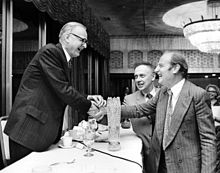
Image: Wikimedia Commons
James Watson and Francis Crick (right), co-originators of the double-helix model, with Maclyn McCarty (left).
A frequent , but difficult philosophical question is whether human genetics could pass memories or experiences to subsequent generations. A couple or attempts at answering at least part of that question involved the replication accuracy using DNA as a data storage medium. In a paper published in Nature in January, 2013, scientists from the European Bioinformatics Institute and Agilent Technologies proposed a mechanism to use DNA’s ability to code information as a means of digital data storage. The group was able to encode 739 kilobytes of data into DNA code, synthesize the actual DNA, then sequence the DNA and decode the information back to its original form, with a reported 100% accuracy. The encoded information consisted of text files and audio files. A prior experiment was published in August 2012. It was conducted by researchers at Harvard University, where the text of a 54,000-word book was encoded in DNA. Now, new research indicates it may be possible to both encode and decode either purposeful or inadvertant additions to DNA.
DNA “markings” may transmit learned experiences
Dec. 1, 2013
Courtesy of Nature Neuroscience
and World Science staff
Learned experiences can be transferred through genetic structures—not by changes to genes themselves, but rather, to how they’re “marked” by other molecules, a study reports.
Such “markings” are called epigenetic changes. Scientists in recent years have increasingly recognized them as playing important roles in biological inheritance.
The finding that learned experiences may be transferred this way is part of a recent wave of research overturning what biologists used to assume—that only information in the DNA itself is passed across generations. READ MORE







Leave a Reply